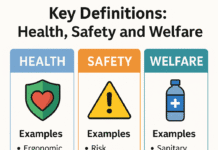
Painting Safety Interview: 50 Questions and Sample Answers
1. What is painting safety?
Answer: Painting safety refers to the precautions and procedures followed to protect workers from hazards such as toxic fumes, falls, and fire risks while performing painting tasks.
2. Why is it important to follow safety procedures while painting?
Answer: Safety procedures prevent health issues from fumes, reduce accident risks like falls, and ensure compliance with workplace safety regulations.
3. What are the major hazards associated with painting?
Answer:
- Exposure to toxic fumes and chemicals
- Fire and explosion hazards
- Falls from heights
- Skin and eye irritation
4. What personal protective equipment (PPE) is required for painting work?
Answer:
- Respirator or mask (for protection from fumes)
- Safety goggles (to prevent eye irritation)
- Gloves (to protect the skin)
- Coveralls (to avoid chemical contact)
5. What is the purpose of a respirator in painting?
Answer: A respirator protects against inhalation of toxic fumes, vapors, and fine paint particles, reducing the risk of respiratory diseases.
6. How do you prevent fire hazards while painting?
Answer:
- Keep flammable materials away from ignition sources.
- Ensure proper ventilation in the painting area.
- Use flame-resistant PPE and tools.
7. What is the importance of proper ventilation during painting?
Answer: Ventilation helps to remove hazardous fumes, reduce exposure to toxic chemicals, and prevent dizziness or suffocation.
8. What precautions should be taken when using spray paint?
Answer:
- Use in a well-ventilated area or spray booth.
- Wear appropriate PPE, including a respirator.
- Avoid spraying near open flames or heat sources.
9. How do you handle and store painting chemicals safely?
Answer:
- Store in properly labeled, sealed containers.
- Keep in a well-ventilated, cool, and dry area.
- Follow Material Safety Data Sheet (MSDS) guidelines.
10. What are the dangers of lead-based paints?
Answer: Lead-based paints can cause serious health issues, including nerve damage, kidney problems, and developmental disorders, especially when inhaled or ingested.
11. How can workers protect themselves from lead exposure while painting?
Answer:
- Use lead-free paints whenever possible.
- Wear respirators and protective clothing.
- Wash hands and face after working with lead-based paint.
12. What are the first aid steps if paint splashes into the eyes?
Answer:
- Rinse eyes immediately with clean water for at least 15 minutes.
- Avoid rubbing the eyes.
- Seek medical attention if irritation persists.
13. What precautions should be taken when painting at heights?
Answer:
- Use proper fall protection (harness, guardrails, safety nets).
- Ensure ladders and scaffolds are stable and secure.
- Never overreach while painting.
14. What are the risks of working in confined spaces while painting?
Answer:
- Limited ventilation can lead to fume buildup.
- Risk of suffocation or poisoning from toxic chemicals.
- Fire hazards from flammable vapors.
15. How should painters dispose of hazardous waste properly?
Answer:
- Follow local regulations for hazardous waste disposal.
- Use designated containers for paint waste.
- Never pour paint or solvents down the drain.
16. What is a Material Safety Data Sheet (MSDS) in painting safety?
Answer: MSDS provides important information about chemicals, their hazards, and safe handling procedures for paints and solvents.
17. What should you do if you feel dizzy or nauseous while painting?
Answer:
- Stop working immediately.
- Move to a fresh air area.
- Seek medical attention if symptoms persist.
18. What are the common fire hazards in painting?
Answer:
- Flammable paints and solvents
- Poor ventilation leading to vapor buildup
- Electrical sparks near painting areas
19. What safety measures should be followed when sanding old paint?
Answer:
- Wear a dust mask to prevent inhaling particles.
- Use wet sanding techniques to minimize dust.
- Dispose of old paint chips safely.
20. What precautions should be taken when using oil-based paints?
Answer:
- Keep away from open flames.
- Store in sealed containers.
- Use in well-ventilated areas.
21. How can you prevent slips and falls while painting?
Answer:
- Keep work areas clean and dry.
- Use non-slip shoes.
- Secure ladders properly.
22. Why should you avoid eating or drinking in the painting area?
Answer: To prevent ingestion of toxic chemicals from paint fumes or contaminated surfaces.
23. What is a painting safety permit?
Answer: It is a document that ensures all necessary safety precautions are in place before beginning painting work.
24. How do you safely clean paint brushes and rollers?
Answer:
- Use the recommended solvent in a ventilated area.
- Wear gloves to avoid skin exposure.
- Dispose of cleaning waste properly.
25. What are the symptoms of paint fume exposure?
Answer:
- Headaches
- Dizziness
- Nausea
- Breathing difficulties
26. How do you prevent over-spraying when using a spray gun?
Answer:
- Adjust the spray gun settings correctly.
- Use masking tape and covers.
- Maintain the right spraying distance.
27. What is the importance of grounding equipment during spray painting?
Answer: Grounding prevents electrostatic buildup, reducing the risk of sparks and explosions.
28. What should be done if a paint spill occurs?
Answer:
- Contain the spill with absorbent material.
- Avoid spreading the spill.
- Dispose of waste as per hazardous waste guidelines.
29. What are VOCs, and why are they dangerous?
Answer: Volatile Organic Compounds (VOCs) are harmful chemicals in some paints that can cause respiratory issues and contribute to air pollution.
30. How do you minimize VOC exposure when painting?
Answer:
- Use low-VOC or water-based paints.
- Ensure proper ventilation.
- Wear appropriate PPE.
31. What precautions should be taken when using water-based paints?
Answer:
- Ensure proper ventilation to reduce moisture buildup.
- Store paints in a cool, dry place to prevent spoilage.
- Avoid contact with eyes and skin by wearing appropriate PPE.
32. What is the correct way to clean up a solvent-based paint spill?
Answer:
- Use an absorbent material (e.g., sand or sawdust) to contain the spill.
- Ventilate the area to reduce toxic fume exposure.
- Dispose of waste as per hazardous material disposal guidelines.
33. Why is it important to check the Safety Data Sheet (SDS) before using paint?
Answer: SDS provides critical information on handling, storage, hazards, and first aid measures for safe paint usage.
34. What type of fire extinguisher should be used for a paint-related fire?
Answer: A Class B fire extinguisher (CO₂ or dry chemical) should be used for fires involving flammable liquids like paint and solvents.
35. How can workers prevent heat-related illnesses when painting outdoors?
Answer:
- Stay hydrated and take regular breaks in shaded areas.
- Wear lightweight, breathable protective clothing.
- Schedule work during cooler hours when possible.
36. What are the risks of using expired or improperly stored paint?
Answer:
- Reduced paint quality and adhesion failure.
- Increased risk of toxic fumes and skin irritation.
- Possible contamination leading to unexpected chemical reactions.
37. How should painting tools be stored after use?
Answer:
- Clean brushes and rollers thoroughly with the appropriate solvent or water.
- Store in a dry, well-ventilated area to prevent mold growth.
- Keep away from direct heat and open flames.
38. Why is proper lighting important for painting safety?
Answer: Proper lighting helps workers see potential hazards, avoid mistakes, and ensure quality application while painting.
39. What are the dangers of inhaling spray paint fumes for a prolonged period?
Answer:
- Respiratory problems such as lung irritation and asthma.
- Neurological effects like dizziness, headaches, and confusion.
- Long-term exposure can lead to organ damage.
40. How should you dispose of empty paint cans safely?
Answer:
- Ensure the can is completely empty and dry.
- Follow local waste disposal regulations for hazardous materials.
- Recycle or dispose of according to environmental guidelines.
41. What should you do if a fire breaks out in the painting area?
Answer:
- Stop all painting activities immediately.
- Use a fire extinguisher suitable for flammable liquids (Class B).
- Evacuate the area and call emergency services.
- Ensure ventilation to prevent fume buildup.
42. How can workers protect themselves from prolonged exposure to paint fumes?
Answer:
- Use proper ventilation, such as exhaust fans or open windows.
- Wear a respirator suitable for paint vapors.
- Take regular breaks in fresh air.
- Use low-VOC paints when possible.
43. What is the risk of static electricity in spray painting?
Answer: Static electricity can cause sparks that may ignite flammable vapors, leading to fires or explosions.
44. How do you prevent static electricity buildup while spray painting?
Answer:
- Ground all spray painting equipment.
- Avoid using synthetic clothing that can generate static.
- Keep the painting area free from flammable materials.
45. What precautions should be taken when painting near electrical equipment?
Answer:
- Turn off and cover electrical panels and outlets.
- Use non-conductive ladders and tools.
- Maintain a safe distance from live wires.
46. What are the safety guidelines for working with paint thinners and solvents?
Answer:
- Store them in sealed, labeled containers.
- Use them in well-ventilated areas.
- Wear gloves and safety goggles to prevent skin and eye contact.
47. What should you do if you accidentally ingest paint or chemicals?
Answer:
- Do not induce vomiting unless directed by a doctor.
- Rinse your mouth with water.
- Seek medical attention immediately.
48. How can painting work be safely performed in confined spaces?
Answer:
- Test for toxic gases and ensure proper ventilation.
- Use a confined space permit and safety procedures.
- Have a trained standby worker outside the confined space.
49. What steps should be taken before using a ladder for painting work?
Answer:
- Inspect the ladder for damage or defects.
- Place it on a stable, level surface.
- Maintain three points of contact while climbing.
- Avoid overreaching while working.
50. What is the safest way to remove old lead-based paint?
Answer:
- Use wet methods (wet sanding or chemical stripping) to reduce dust.
- Wear a respirator and protective clothing.
- Dispose of waste according to hazardous waste regulations.
Environment Safety Interview: 50 Questions and Sample Answers
Offshore Safety Interview: 50 Questions and Sample Answers
Mobile Crane Safety Interview: 50 Questions and Sample Answers
Boom Truck Safety Interview: 50 Questions and Sample Answers
Tower Crane Safety Interview: 50 Questions and Sample Answers
























